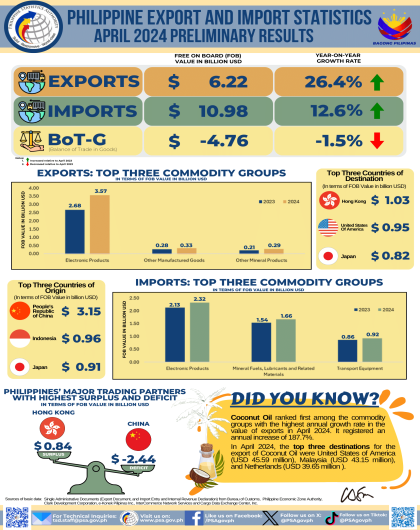Highlights of the Philippine Export and Import Statistics April 2024 (Preliminary)
| |||||||||||||||||||||||||||||||||||||||
p - preliminary
r - revised
Top 10 Philippine Imports from All Countries: May 2009 | |||
Gainers | Losers | ||
Miscellaneous Manufactured Articles | 19.7 | Iron and Steel | -60.3 |
Cereals and Cereal Preparations | 18.2 | Mineral Fuels, Lubricants and Related Materials | -57.5 |
Medicinal and Pharmaceutical Products | 5.1 | Industrial Machinery and Equipment | -34.4 |
Organic and Inorganic Chemicals | 4.8 | Plastics in Primary and Non-Primary Forms | -30.2 |
|
| Transport Equipment | -29.0 |
|
| Electronic Products | -12.3 |
JANUARY TO MAY TOTAL TRADE VALUED AT $30.072 BILLION
Total external trade in goods for January to May 2009 reached $30.072 billion, representing a 33.7 percent decline from $45.338 billion recorded during the same period in 2008. This was attributed to the 32.9 percent decrease of total imports to $16.257 billion from $24.243 billion reported in the first five months of 2008. Similarly, total exports went down by 34.5 percent to $13.815 billion from $21.096 billion posted in January to May 2008. Thus, the balance of trade in goods (BOT-G) for the Philippines under review registered a $2.442 billion deficit from $3.147 billion deficit in the same 5-month period last year.
Figure 1A Philippine Trade Performance in January - May : 2009 and 2008
(F.O.B. Value in Million US Dollar)
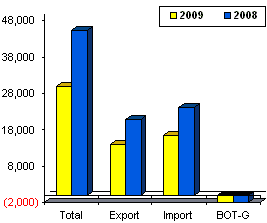
Figure 1B Philippine Trade Performance in May : 2009 and 2008
(F.O.B. Value in Million US Dollar)
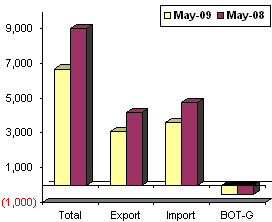
MAY 2009 IMPORTS DROPPED BY 24.3 PERCENT
Total merchandise trade for May 2008 fell by 25.5 percent to $6.704 billion from $9.001 billion in May 2008. Total exports amounted to $3.088 billion or 26.9 percent lower from last year’s $4.225 billion. Similarly, the countrys total merchandise imports for May 2009 plunged by 24.3 percent to $3.617 billion from $4.776 billion in May 2008. However, month-on-month, it expanded by 18.9 percent from $3.042 billion recorded in April 2009.
ELECTRONIC PRODUCTS ACCOUNTED FOR 36.0 PERCENT OF IMPORT BILL
Accounting for 36.0 percent of the aggregate import bill, payments for Electronic Products (including consigned and direct importation using the expanded coverage of electronic products) in May 2009 amounted to $1.301 billion. It slowed down to 12.3 percent over last year's figure of $1.483 billion. This was due to the 12.7 percent decrease in Components/Devices (Semiconductors) which comprised the biggest share of 26.6 percent among the major groups of electronic products. However, electronic products rose by 40.7 percent month-on-month from $924.76 million in April 2009.
Imports of Mineral Fuels, Lubricants and Related Materials comprising 14.0 percent of the total imports in May 2009 ranked second, valued at $505.25 million over the previous year’s level of $1.190 billion.
Cereals and Cereal Preparations, amounting to $348.37 million was the RPs third top import for the month with 9.6 percent share to total imports and showed a positive annual growth of 18.2 percent.
Contributing 4.0 percent to the total import bill and RPs fourth top imports in May 2009 was Transport Equipment with payments placed at $144.29 million. The amount decreased by 29.0 percent from last years amount of $203.30 million.
Fifth in rank and with 3.4 percent share, Industrial Machinery and Equipment registered $121.76 million worth of imports, lower by 34.4 percent from its year ago level of $185.53 million.
Organic and Inorganic Chemicals ranked sixth, representing 3.1 percent of the total imports recorded $112.09 million worth of imports up by 4.8 percent from its year ago level of $107.01 million.
Rounding up the list of the top ten imports for May 2009 were Iron and Steel, accounting for $72.75 million and showed the highest negative growth of 60.3 percent among the top ten imports; Plastics in Primary and Non-Primary Forms amounting to $64.56 million; Medicinal and Pharmaceutical Products, $61.89 million; and Miscellaneous Manufactured Articles, $56.86 million and posted the highest positive growth of 19.7 percent.
Aggregate payment for the countrys top ten imports for May 2009 reached $2.789 billion or 77.1 percent of the total import bill.
Figure 2 Philippine Top Six Imports in May : 2009 and 2008
(F.O.B. Value in Million US Dollar)
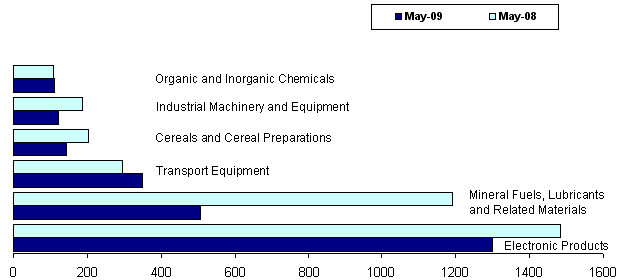
RAW MATERIALS AND INTERMEDIATE GOODS ACCOUNTED FOR 39.8 PERCENT OF THE TOTAL IMPORTS
Accounting for 39.8 percent of the total imports, payments in May 2009 for Raw Materials and Intermediate Goods amounted to $1.438 billion or 15.8 percent decline over last year's figure of $1.708 billion. Compared to the previous months level, purchases went up by 35.7 percent from $1.059 billion. Semi-Processed Raw Materials having the biggest share of 33.6 percent and valued at $1.217 billion decreased by 23.1 percent from $1.581 billion level a year ago.
Capital Goods, contributing 29.1 percent to the total imports, plummeted by 10.3 percent year-on-year to $1.053 billion from $1.174 billion. Similarly, Mineral Fuels, Lubricants and Related Materials with 14.0 percent share, declined by 57.5 percent to $505.25 million from $1.190 billion in May 2008.
Purchases of Consumer Goods amounted to $572.62 million or a negative growth of 8.9 percent from $628.77 million in May 2008, while Special Transactions dropped by 36.6 percent to $47.33 million from $74.66 million in May 2008.
Figure 3 Philippine Imports by Major Type of Goods in May : 2009 and 2008
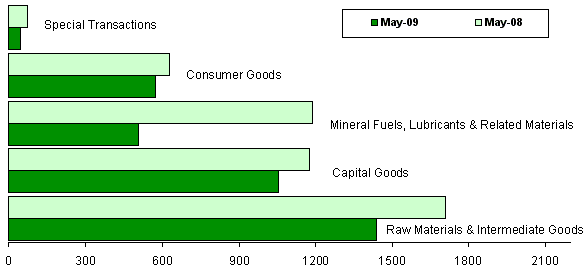
UNITED STATES ACCOUNTED FOR 12.2 PERCENT OF IMPORT BILL
United States of America (USA) which includes Alaska and Hawaii was the countrys biggest source of imports for May 2009 with 12.2 percent share, recorded payments worth $439.69 million, a decline of 19.5 percent year on year from $545.98 million. Revenue from the countrys exports to USA, on the other hand, reached $495.13 million, generating a total trade value of $934.82 million and $55.44 million trade surplus for the Philippines.
Japan (including Okinawa) with 10.9 percent share of the total import bill amounting to $393.28 million followed as the second biggest source of imports for May 2009. This value is lower by 21.8 percent from $503.21 million in May 2008. Exports to Japan amounted to $506.44 million, yielding a two-way trade value of $899.73 million and a trade surplus for RP of $113.16 million.
Peoples Republic of China, came third, accounting for 9.3 percent share of the total import bill in May 2009 went down by 2.8 percent to $337.23 million from $346.84 million during the same month in 2008. Exports to Peoples Republic of China amounted to $302.73 million resulting to a total trade value of $639.95 million and a trade deficit of $34.50 million.
Rank fourth in May 2009 and with 8.6 percent share was Singapore valued at $312.21 million. This amount decreased by 35.1 percent from $480.72 million posted in May 2008. Exports toSingapore amounted to $215.01 million resulting to a total trade value of $527.22 million and a trade deficit of $97.20 million.
Fifth in rank is Taiwan, representing 7.6 percent of the total import bill in May 2009, amounting to $272.96 million. Meanwhile, export receipts from Taiwan in May 2009 reached $117.99 million yielding a total trade value of $390.95 million and a trade deficit of $154.97 million.
Other major sources of imports for the month of May 2009 were Republic of Korea, $228.26 million;Vietnam, $225.04 million; Thailand, $185.38 million; Hong Kong, $130.98 million; and Indonesia, $114.50 million.
Payments for imports from the top ten sources for May 2009 amounted to $2.640 billion or 73.0 percent of the total.
Figure 4 Philippine Imports by Country in May : 2009
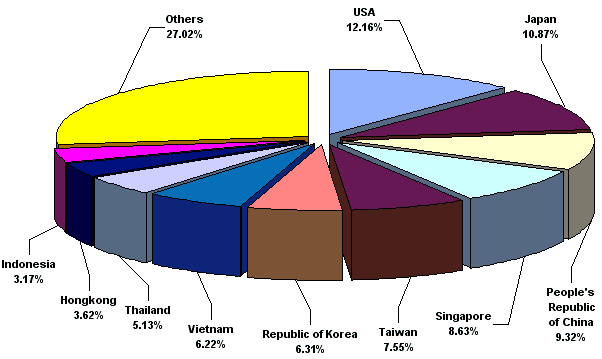
Technical Notes:
1. Adjustments on electronic import statistics are based on the transactions that pass through the Automated Cargo Operating System (ACOS) of the Bureau of Customs (BOC).
2. Starting with the January 2007 Press Release, analysis and tables are based on the 2004 Philippine Standard Commodity Classification (PSCC) groupings. This is in compliance with NSCB Resolution No. 03, Series of 2005 entitled "Approving and Adopting the 2004 Philippine Standard Commodity Classification" by all concerned government agencies and instrumentalities.
(Sgd.) CARMELITA N. ERICTA |
Source: Foreign Trade Statistics Section
Industry and Trade Statistics Department
National Statistics Office
Manila, Philippines

